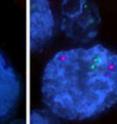Study shows gene positions may aid cancer diagnosis
Related images
(click to enlarge)
Certain genes switch their nuclear position in tumor cells, offering a potential new method of diagnosing cancer, say researchers from the National Cancer Institute. The study by Meaburn et al. will be published online December 7, 2009 (www.jcb.org) and in the December 14, 2009 print issue of the Journal of Cell Biology (JCB). Individual genes preferentially localize to specific points within the nucleus. The reasons for this aren't known, but the positions can be reshuffled during differentiation. Meaburn et al. wondered whether genes might also rearrange during carcinogenesis, when large-scale changes in nuclear morphology occur. The researchers previously identified four genes that shift their location in a 3D culture model of early breast cancer, and now turned their attention to human tissue.
The team analyzed 20 genes and found that most were positioned uniformly in healthy breast tissue from numerous individuals. Eight of these genes consistently relocated in the nuclei of invasive breast cancer cells, including HES5, which had an altered localization in all tumors examined. The researchers were able to distinguish between normal and diseased tissue on the sole basis of these genes' nuclear localization with success rates similar to current clinical tests.
The next step, says lead author Karen Meaburn, will be to repeat the study on a larger number of samples. HES5 is unlikely to be repositioned in all of these, so the authors hope to identify a set of genes that, in combination, can accurately diagnose breast cancer. The approach may be useful for prognosis, too—in vitro studies suggest that gene movements are an early event in cancer development, so gene positions might provide an indication of the cancer's future progress.
Source: Rockefeller University Press
Articles on the same topic
- Alcohol consumption increases risk of breast cancer recurrenceThu, 10 Dec 2009, 17:24:56 UTC
- Alcohol consumption may increase breast cancer recurrence riskThu, 10 Dec 2009, 17:24:53 UTC
- Sonic Hedgehog variations linked to recurrence, survival and response to therapy of bladder cancerWed, 9 Dec 2009, 16:15:10 UTC
- Women with breast cancer who consume soy food have lower risk of cancer recurrenceTue, 8 Dec 2009, 21:28:37 UTC
- Genetic variations indicate risk of recurrence, secondary cancer among head and neck cancer patientsMon, 7 Dec 2009, 19:37:08 UTC
- News brief -- childhood cancer survivor study report: Late recurrence is a risk for some cancersFri, 4 Dec 2009, 21:37:10 UTC
Other sources
- Vital Signs: Risks: Study Ties Alcohol to Recurrence of Breast Cancerfrom NY Times ScienceMon, 14 Dec 2009, 21:28:11 UTC
- Alcohol consumption increases risk of breast cancer recurrence, study findsfrom Science DailySun, 13 Dec 2009, 5:14:12 UTC
- Vital Signs: Risks: Study Ties Alcohol to Recurrence of Breast Cancerfrom NY Times HealthFri, 11 Dec 2009, 7:14:06 UTC
- Alcohol consumption increases risk of breast cancer recurrencefrom PhysorgThu, 10 Dec 2009, 17:28:40 UTC
- Women with breast cancer who consume soy food have lower risk of cancer recurrencefrom Science DailyWed, 9 Dec 2009, 18:28:29 UTC
- Soy doesn't harm, and may even help, breast cancer survivors, study findsfrom LA Times - ScienceTue, 8 Dec 2009, 23:49:15 UTC
- Women with breast cancer who consume soy food have lower risk of cancer recurrencefrom PhysorgTue, 8 Dec 2009, 21:56:17 UTC
- Genetic variations indicate risk of recurrence, secondary cancer among head and neck cancer patientsfrom Science BlogMon, 7 Dec 2009, 20:42:24 UTC
- Genetic variations indicate risk of recurrence, secondary cancer among head and neck cancer patientsfrom PhysorgMon, 7 Dec 2009, 20:21:23 UTC
- Childhood cancer survivor study report: Late recurrence is a risk for some cancersfrom PhysorgFri, 4 Dec 2009, 23:42:12 UTC
- Protein Markers Predict Risk of Melanoma Recurrencefrom PhysorgFri, 4 Dec 2009, 0:28:31 UTC
